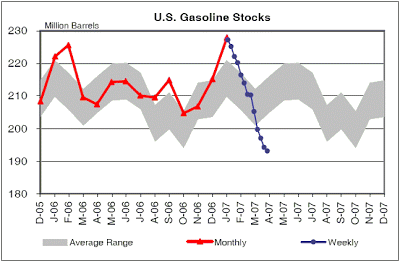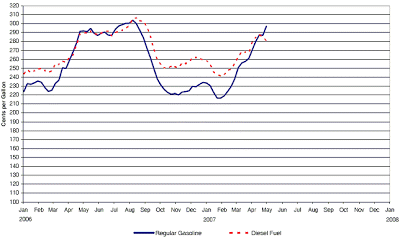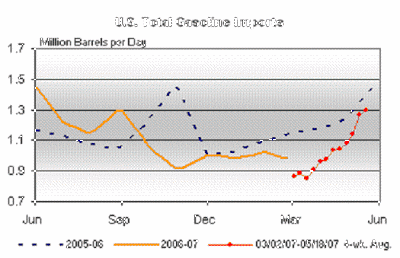Note: This essay was published at Financial Sense on May 31, 2007.
Introduction
As of this writing in late May 2007, gasoline prices have increased by over $0.70 per gallon since March. This is great news if you bought gasoline futures in March, but bad news for most consumers, and the politicians that answer to them. If you knew where to look, there were early indications of trouble brewing last winter. By February to early March there were definite signs pointing toward an impending problem – over 2 months before this became a “crisis” in the view of the public. On March 9, 2007 I warned that gasoline supplies “could pose problems in the coming weeks” and “higher gasoline prices will be the norm rather than the exception in upcoming years.” So, how did this situation happen?
In Part I, I will discuss the short term causes that have resulted in the current supply crunch, and explain what factors potentially signal higher prices. In Part II, I will address longer term factors and policy decisions that have contributed.
Gouging: The Lazy Man’s Answer
A large portion of the population – including many politicians, judging from recent hearings into the matter – seem to believe that “price gouging” is the explanation for higher gas prices. This explanation reeks of an inability to actually understand the issues. Of course oil companies do seek to maximize profits, but they can’t do so by merely raising the price of gasoline. That is done by the market, and if prices go up the companies earn more money. The cause of higher oil company profits is that oil and gasoline prices have gone up. But many have cause and effect mixed up. They believe that the cause of higher gasoline prices is “profiteering.” If that were the case, the oil industry would not be cyclical.
People seem to understand that when the price of gold rises, gold mining companies make more money. And there doesn’t seem to be a widespread misconception that the reason they are making more money is that they just decided to raise the price of gold. People understand that they can’t do this. It is the same with oil companies and the price of gasoline. (I will address the issue of withholding supply in Part II).
The Role of OPEC
However, there is one caveat. OPEC does control enough of the world’s oil production that they have historically managed oil supplies to maintain an oil “price band” that they view as fair. Only 5 years ago the average retail gasoline price was $1.35/gallon. At that time, the world average price for crude oil was $23.47/bbl. By 2006, crude oil had risen to $60.32 and gasoline to $2.57. Thus the retail price of gasoline had risen by $1.22/gallon. Oil, with 42 gallons in a barrel, had risen by $36.85, or $0.88/gallon. Given that a barrel of oil does not yield 100% finished products, we can attribute most – and potentially all – of the gasoline price increase from 2002 to 2006 to the increase in the price of oil.
2007 Adds a Twist
However, in 2007, the recent average U.S. retail gasoline price of $3.22 – $0.65 higher than in 2006 – coincided with a world crude oil price of $64/bbl. That is only $0.09/gallon higher than the 2006 price, so clearly this small increase in crude prices does not explain the recent gasoline price rise. So let’s look at the short term factors behind the 2007 price run-up.
A graph extracted from the Weekly Petroleum Status Report published by the EIA (see the note at the end) gives a picture of the gasoline inventory situation over the past year:
Compare that to the chart for retail gasoline (and diesel) price over the same time period:
The relationship is clear. As gasoline supplies were rapidly pulled down, gasoline prices lagged at first, and then raced to catch up. It was apparent by February or March that the rate of descent was highly unusual, and sharply higher prices would be required to stop the plunge. On May 16, 2007 the EIA reported:
Gasoline inventories have recently been drawn down at a dramatic rate to bridge the gap between supply and demand. Over 12 consecutive weeks during February, March, and April, total gasoline inventories declined by a cumulative total of more than 34 million barrels (15 percent). This is the sharpest decline in gasoline inventories over a consecutive 12-week period in EIA’s recorded historical data.
So that answers the immediate question of why gasoline prices rose. The obvious follow-up is “What caused such a sharp decline in gasoline inventories?“
Reason 1: Record Winter Demand
Figure 2 shows that at the end of summer in 2006, gasoline prices plunged. This had two effects that ultimately resulted in the record high prices in the spring of 2007: Demand rose and gasoline imports fell. The plunge had the effect of spurring record demand starting in the fall of 2006 and continuing into the winter of 2007. Gasoline demand was regularly hitting 9.5 million barrels per day – an unprecedented level for fall or winter, and more typical of summer demand. While inventories were able to stay ahead of the demand until about January of 2007, when refineries (in the U.S and in Europe) started to take outages for annual maintenance, inventories started to plummet. Gasoline inventories do tend to drop every spring, but the lower gasoline prices resulted in a record-breaking inventory draw.
Reason 2: Lower Refinery Utilization
In the summer of 2005, crude oil inputs to refineries reached the level of 16.5 million barrels per day. Refinery utilization (the crude inputs/total refinery capacity) was as high as 98% on a weekly basis. But refineries have not matched those levels since Hurricane Katrina. Refinery inputs have only managed to reach 16 million barrels a day on two separate weeks since 2005, and have spent most of 2007 below 15 million barrels per day. Refinery utilization that was reaching 98% prior to Katrina has not been above 93.8% since.
One reason for this is that Hurricane Katrina resulted in the shut down of many refineries, which forced others to postpone their fall maintenance in order to keep the market supplied. Instead of stopping to do needed repairs, the refineries were instead asked to operate at full throttle. While this helped alleviate the immediate supply crunch, it also introduced a number of problems that have lingered. Imagine that your car is in bad need of a tune-up, but instead of taking it out of service, you decided to go out and run it at full speed for another 6 months or a year. That’s what the refineries did, and they haven’t yet fully recovered from lingering maintenance problems that resulted.
Another major factor that has had a ripple effect through U.S. refining was the BP explosion in Texas City on March 23rd, 2005 that cost 15 people their lives. Not only has production not been fully restored at this refinery – one of the 5 largest in the U.S. – but the subsequent investigation headed up by Former US Secretary of State James Baker pointed out numerous process safety issues in BP’s operations. Furthermore, the investigation report noted that these safety issues were not limited to BP.
The impact of this is that it has resulted in a much more cautious approach to refinery operations. There is far less hesitation to shut down a refinery if there appears to be a problem, and that is what is happening. Refiners are taking a meticulous approach in their operations to prevent another Texas City – but at the price of reduced utilization.
On top of the Texas City incident, BP also had a recent fire at their Whiting, Indiana refinery – also one of the 5 largest in the U.S. This refinery has been running at half capacity since the March 22nd, 2007 blaze. While these unplanned outages are not limited to BP, because these two refineries are among the 5 biggest in the U.S., they have been a major contributor toward the spring gasoline supply crunch.
In Part II, I will go into more detail behind the longer-term refinery issues – such as failure to keep up with growing demand – that have contributed to the current situation.
Reason 3: Falling Gasoline Imports
The third factor that resulted in the rapid inventory drop is that gasoline imports fell. There are two reasons for this. First, as prices plunged in late 2006, the profit margins for European gasoline exporters plunged as well. This provided a disincentive for exporting gasoline to the U.S.
Second, between the summer and fall of 2006 the U.S. dollar fell by around 10% against the Euro and the British Pound. Since U.S. fuel imports are paid in dollars, the exporters are receiving less money unless the price rises to compensate. For example, Great Britain is currently the largest volume source of U.S. gasoline imports. In the summer of 2006, $1 was worth 0.55 British Pounds. If gasoline is $2 a gallon, a British exporter receives 1.10 British Pounds per gallon of gasoline sold in the U.S. By the fall of 2006, the exchange rate had dropped to 0.50 British Pounds per U.S. dollar. At the same $2 a gallon, a British exporter only received 1.0 Pounds per gallon of gasoline sold in the U.S. Because gasoline prices were falling as well, this provided a double disincentive for gasoline exporters.
As can be seen in Figure 3, gasoline imports fell in late 2006, and imports have remained consistently below the previous year’s levels. Given that demand was at a record high, utilization in the U.S. was down, and imports were lower as well, it is not surprising that inventories were drawn down so rapidly, nor that the price reacted as it did. This year’s gasoline situation was a perfect storm combining much greater demand with lower supplies. The outcome was inevitable: Record high gas prices.
Summary
Gasoline prices have risen for a number of factors. The cost of crude has gone up sharply in the past few years, adding about $1/gallon to the base cost of gasoline. In the fall of 2006, gasoline prices fell to their lowest levels in a year. This spurred record demand in the fall and winter of 2006, and discouraged gasoline imports (which were also discouraged by a weaker dollar). Those factors combined to draw down gasoline inventories in the spring of 2007 at the fastest rate in EIA history. When an inventory draw is that steep and persistent, gasoline prices must rise sharply to reign in demand and balance it with available supply.
Looking ahead, the supply/demand picture will likely remain very tight for years, although there will be occasional relief depending on the season. But it looks to be the rule, rather than the exception, that higher gasoline prices are here to stay. A return to sub-$2/gal gasoline appears highly unlikely (again, some seasonal exceptions are possible).
In Part II, I will look at longer term factors that have adversely impacted U.S. gasoline supplies.
Note: This Week in Petroleum
If you follow the petroleum markets, or you just want to know what is going on in the world of energy, the weekly reports from the Energy Information Administration (EIA) are invaluable. Each week the EIA releases a report detailing information on petroleum and product inventory levels, imports, prices, refinery utilization, etc.
Some links you may want to bookmark, if you want to be more informed about what’s happening in the world of energy, are: Text File of Highlights. This is the first report to come out. It is released at 10:30 a.m. EST each Wednesday. This is a text file that provides all of the important details, although without the graphics. The second is: This Week in Petroleum (TWIP). This is a comprehensive and graphical look at the trends and developments. The report is released at 1 p.m. EST each Wednesday. A more comprehensive view can be found in the Weekly Petroleum Status Report, also released each Wednesday at 1 p.m. EST.
Previous Essays on Gasoline Prices
Saudi Arabia and Gas Prices by Stuart Staniford at The Oil Drum



On 5/21/2007 Ron Paul (TX) introduced HR 2415 to address gasoline supply.
Hi Robert,
You know those of us in ASPO Australia are hooked on the Asian TAPIS price of crude oil.
My theory is that the price of gasoline in the US is now being set by the marginal cost of shipping an extra tanker of gasoline from Asia.
That extra tanker has to be refined from crude which has been US$75-78 for the last two weeks. Then you have to add the cost of shipping it across the Pacific (any idea how much that is?).
So U.S. gasoline prices are inconsistent with $60+ WTI but not inconsistent with Asian oil prices.
cheers
Phil
http://www.philhart.com
I think Schumer et. al. really do understand that supply and demand set the price, but they are mentally thinking that the gasoline business should operate on a regulated utility model, and therefore that refiners’ spread should be capped when supplies are tight. (Presumably, Mr. Schumer would be willing to guarantee them a profit if prices drop – yeah right.) The fact that forcing the price below the market-clearing price would create shortages and/or require rationing appears not to have occurred to the hon. senator.
BTW has anyone analyzed how increasing the gasoline tax might help? The price for every gallon is set by the most expensive marginal gallons, isn’t it? It seems to me that if the price perceived by consumers were higher, they’d demand less, backing off the most expensive gallons and thus lowering the (wholesale) price for all the rest. The “windfall” profits would shrink while the price at the pump would go up by less than the amount of the tax, and the government could use the net difference to fund energy research or whatever.
P.S. RR I hope you are well now.
Like your “top level” analysis. It would be interesting to explore the topic as to why there are less gasoline and diesel imports than in previous times. It is my understanding that foreign refineries are hard pressed to meet our new Tier II sulfur standards- which has effectively become a barrier to entry into the US market-place.
OPEC is cutting production to stay in Fat City. Can’t blame ’em. Marginal cost of a barrel of crude in OPEC-land is probably under $3, maybe under $2.
OPEC has been helped by a wonderful string of (rotten) luck: Iran, Iraq, Libya, Venezuela and Russia all being run by crackpots or thugs. I figure there is 10 mbd sitting on the sidelines (compared to what free enterprise development would achieved in those countries over the past 10 years).
And the world economy is growing.
Still, you gotta wonder what will curtial US gasoline consumption. Morgan Stanley says we actually have perhaps 20 million illegal immigrants in the US. I guess all of them are working, and perhaps driving to work etc. 2 million more a year enter. They work hard, I am not immigrant bashing.
Still, the klaxons rang that we would not have gasoline over Memorial Day, and we had plenty, and stocks are building now. We may be through the worst patch.
Gasoline demand may start to go down now that we are at record highs (though still just at prices obtained 27 years ago, during the last energy “crisis.”)
We should reach 6 percent supply from ethanol within three years. Maybe that will help.
Here is a link to an NBC news story about beef fat to renewable diesel and manure to energy to ethanol.
NBC News: Going Green
Converting waste to energy helps EROI, but it still doesn’t make much sense. I don’t see the significance to ethanol. Why not turn manure into steam for electricity or to run some other business.
I blame Lord Browne. He all but eliminated maintenance spending on their Alaskan pipeline. I imagine it was the same story at BP’s refineries.
Converting waste to energy helps EROI, but it still doesn’t make much sense.
Gotta disagree with you there, King. Waste is the only kind of renewable energy that makes any sense IMHO.
I don’t see the significance to ethanol. Why not turn manure into steam for electricity or to run some other business.
I agree about the ethanol. But if you treat the ethanol plant as a given, it makes more sense to burn manure for heat, rather than natural gas.
As I mentioned before, I think the ethanol craze would work itself out of the system shortly, provided our elected officials can keep themselves from keeping it on life support. We can only hope.
I meant to say that burning the manure makes sense, but making the ethanol doesn’t.
Panda Energy is just using a waste heat source for making a fuel with a crappy EROI. Burning the manure didn’t help the EROI of ethanol at all. That heat could have been used to heat a factory or drive a steam turbine producing electricity or some better alternative use.
Pardon the colorful analogy, burning manure to produce ethanol is like putting lipstick on a hog.
Would agree with you. Supply & demand for corn, coupled with overbuilding ethanol plants will likely sort out the ethanol business.